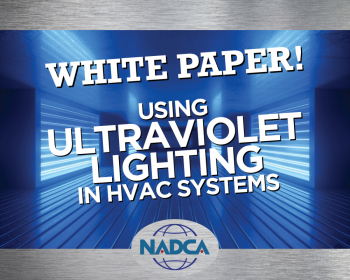Looking for Tips on Using Ultraviolet Lighting in HVAC Systems? We’ve Got Them!
COVID-19 has certainly created buzz around ultraviolet lighting, particularly among companies looking to add UV technology to help address concerns over air quality in workplace settings. Awareness of indoor air quality in general has increased substantially in recent years, and the systems that supply air to our living and working spaces are critical to the maintenance of a healthy indoor environment.
It is commonly agreed that source removal of contaminants remains the single best method for cleaning and decontaminating HVAC systems. The use of ultraviolet lighting within the system is certainly one of the tools that can be used to improve air quality, since UV light can decrease the level of airborne pathogens and allergens traveling through the HVAC system, and eventually into the indoor air environment.
Currently, a broad range of information exists regarding the use and effectiveness of ultraviolet lighting in HVAC systems, however, the efficacy of UV light disinfection in regards to the virus that causes COVID-19 is not known. The CDC has provided guidance on use of germicidal ultraviolet as an alternative disinfection method, but the EPA cannot confirm whether, or under what circumstances, such products might be effective against the spread of COVID-19.
While there are still so many unanswered questions about ultraviolet light and coronavirus, we do know a LOT about UV technology and indoor air quality in general!

What is Ultraviolet Lighting?
A rainbow is made when light shines through droplets of water and breaks into its various colors. The light just beyond the violet end of the spectrum is not visible to the naked eye, and is called ultraviolet (which means ‘beyond violet’), commonly known as UV light.
There are three types of UV light: A, B, and C. Each represents a different section of the UV light spectrum. Type C, known as UVC, is the form used for germicidal activity.
When UVC light is used for germicidal purposes, it is referred to as UVGI, which means ultraviolet germicidal irradiation.
UVGI “deactivates” or kills microorganisms, including viruses, bacteria, molds, and other fungi by disrupting their DNA. “Deactivated” means the organism is not necessarily killed, but that it can no longer reproduce. Some deactivate after microseconds of exposure, while others require much longer exposure. The effectiveness of UVGI depends on a number of factors, including:
- Intensity of lamp(s)
- Length of time of exposure
- An organism’s ability to withstand UVGI
- The presence of particulate that may protect the organism from exposure by providing shadows or a shielding effect
- Increased humidity which may protect the organism
- Location of the UVCl amp(s)
- Ambient temperature
- Number of lamps
- Reflectivity of surrounding surfaces
Among other things, UVC is used for:
- Upper-room air disinfection
- Surface disinfection
- HVAC air disinfection
- Cooling coil disinfection
- Water treatments
- Curing plastics and other materials
- Printing
- Chemical processing
Using UV Light in HVAC Systems
Bioaerosols are airborne particles that contain living organisms, or were released from living organisms. They exist in the air around us, and in the air that passes through HVAC systems. Inactivating them reduces the risk of occupant illness, allergic response, and infection from microbes. The use of UVGI to reduce microorganisms on the surfaces and bioaerosols in the airstreams of HVAC systems dates back to about 1900.
UVGI in HVAC systems has been studied and reviewed extensively by many scholars across the globe, and by professional organizations like ASHRAE (the leaders in the HVAC engineering field), and by government agencies.
UVGI lamps are categorized by the internal pressure of the gas in the lamp. Low-pressure lamps are, by far, the most commonly used in HVAC systems. Medium-pressure lamps are typically used where critical levels of disinfection are required. On hard surfaces, like evaporator coils and drain pans, where UVGI exposure is constant and within adequate proximity, the kill rate for organisms contacted is up to 99.9%.
However, deactivating bioaerosols is a more complex activity. A common question asked is: How effective is UVGI at killing (deactivating) bioaerosols in the airstreams of HVAC systems? The answer is, technology can be effective, but many variables can impact its effectiveness.
Best Practices:
It is generally agreed that source removal of contaminants remains the single best method for cleaning and decontaminating HVAC systems. The application of UVGI in HVAC systems can be an effective means to reduce airborne pathogens, but only if lamps are properly and strategically installed in sufficient number and/or intensity, and also are properly maintained.
If installed in HVAC systems without proper training, UVC lamps can be largely ineffective and can create hazards or material decomposition that negatively impact the functioning of the system, and puts occupants and installers at risk.
It’s recommended that installers are well-educated on the materials from the manufacturer. It is also recommended that proper safety precautions be taken to protect workers and occupants from unnecessary UVGI exposure and the effects of lamp breakage, should it occur.
Did you know NADCA has a great WHITE PAPER with guidance for using ultraviolet lighting in HVAC systems? CLICK HERE to download it.
Download NADCA’s White Paper on Ultraviolet Lighting Applications in HVCA Systems Here
